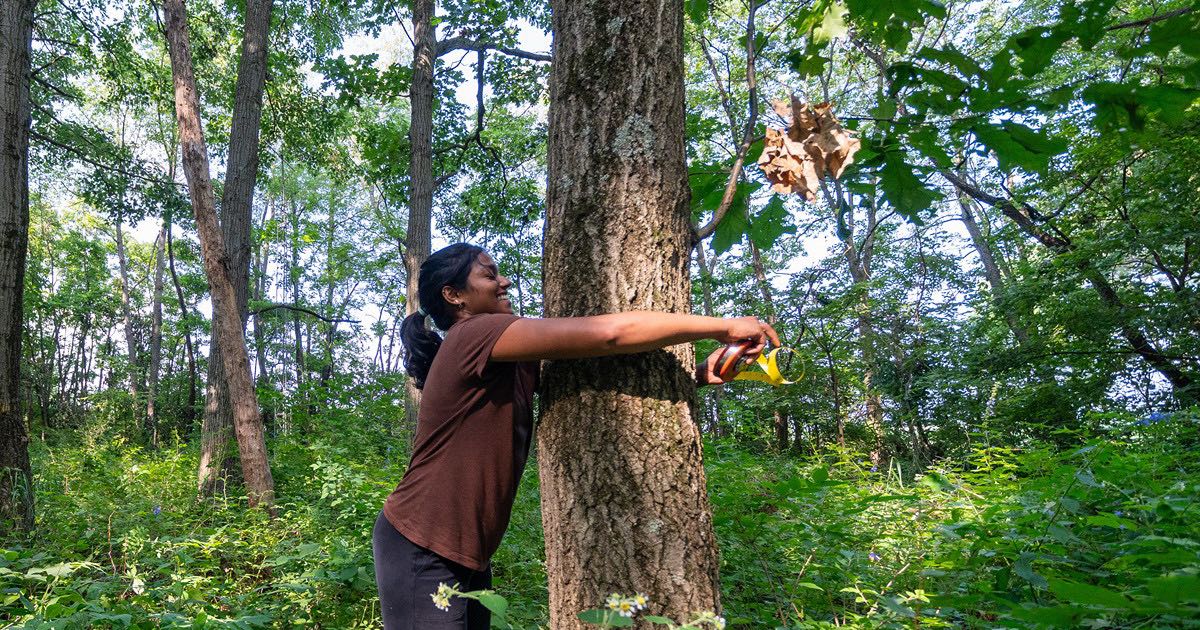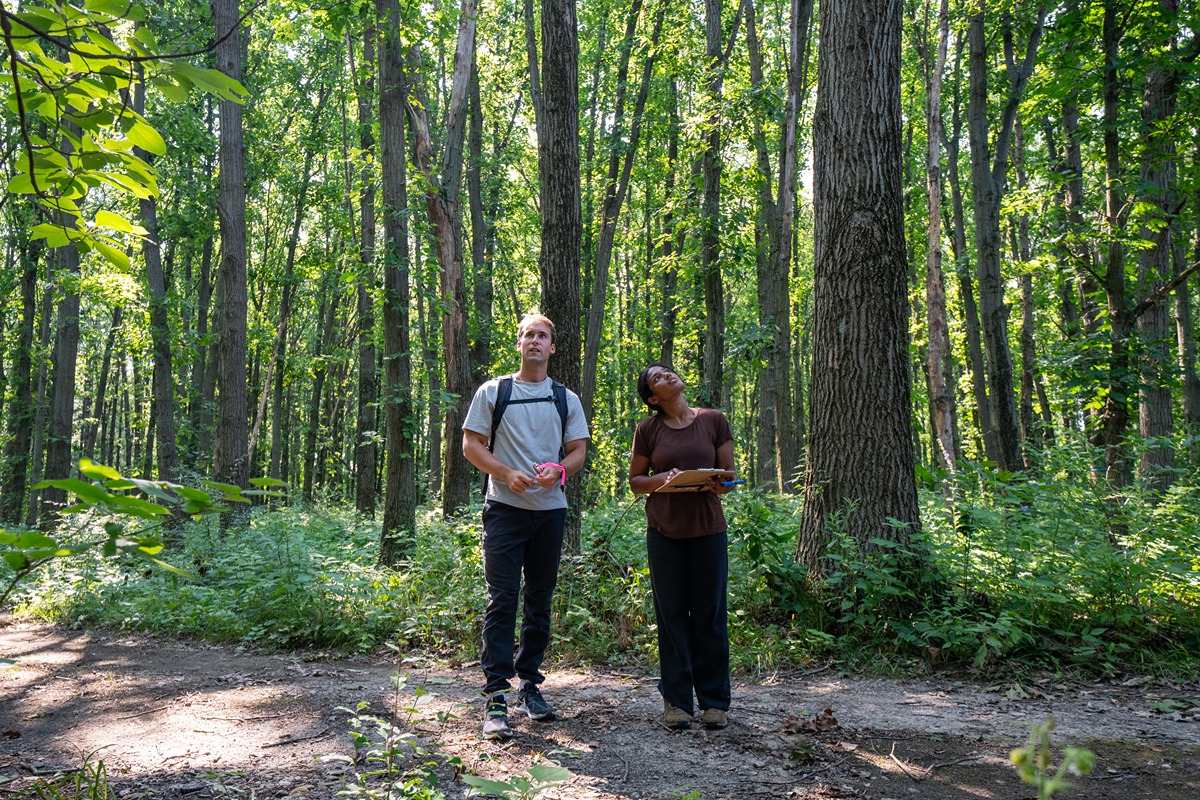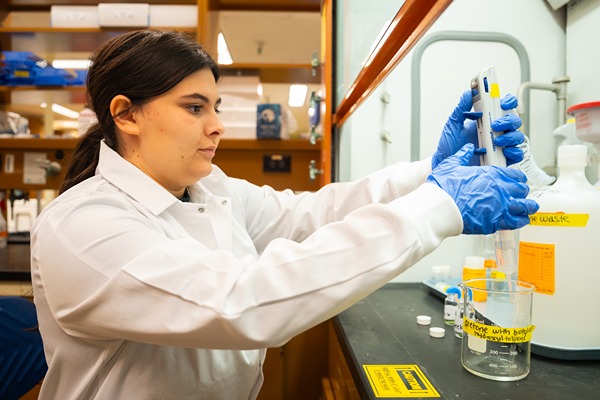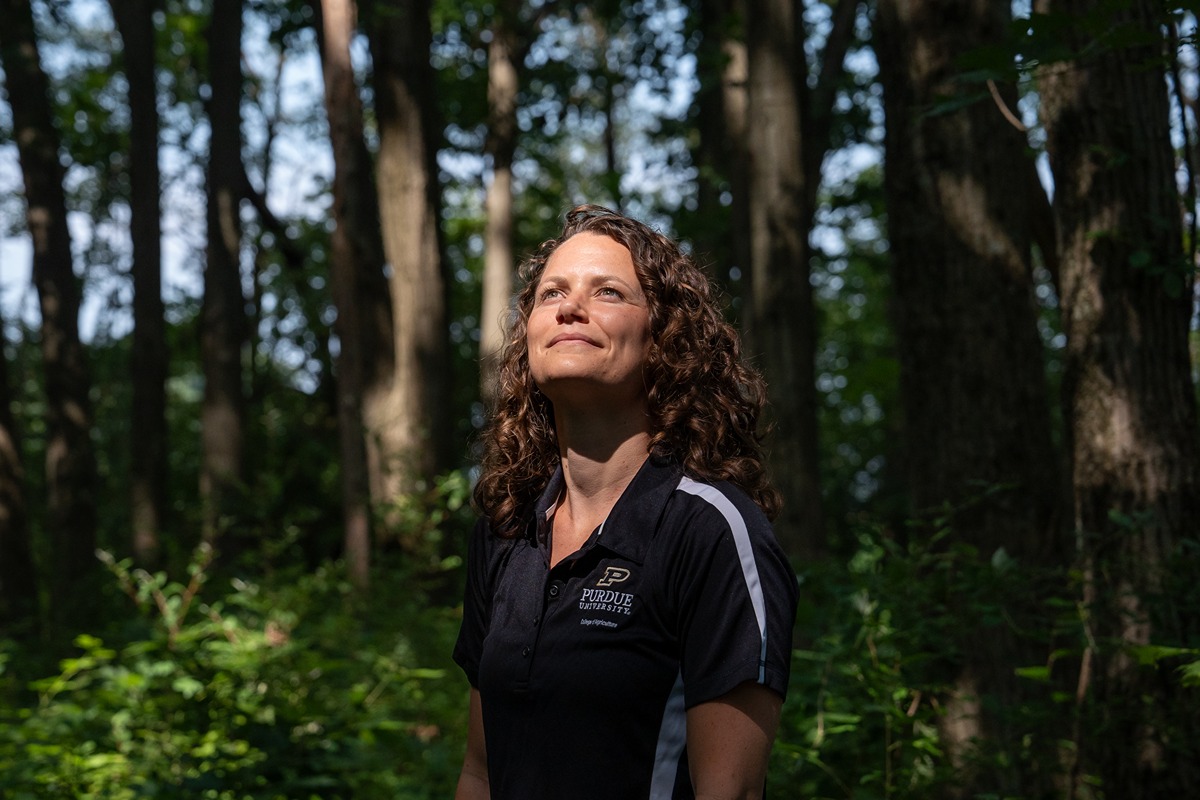Journey along the sugar highway with the new tree physiology lab at Purdue
Hold a leaf up to the light, and the branching network of veins stands out against the thinner, brighter background. Like blood circulating through the human body, these lines are a sophisticated transport network for sugar, water and nutrients. They flow into the stem or trunk, down through the roots and back up into each leaf.
 Morgan Furze, an assistant professor at Purdue, let her interest in climate change guide her to trees and their resource highway. Her lab in the Departments of Botany and Plant Pathology (BPP) and Forestry and Natural Resources (FNR) studies how these woody plants respond to environmental stress using that transport network.
Morgan Furze, an assistant professor at Purdue, let her interest in climate change guide her to trees and their resource highway. Her lab in the Departments of Botany and Plant Pathology (BPP) and Forestry and Natural Resources (FNR) studies how these woody plants respond to environmental stress using that transport network.
Plants use their green chlorophyll to soak up light from the sun and convert it into the usable energy that makes life on Earth possible. This process, photosynthesis, also requires carbon dioxide, which plants take in through tiny openings on their leaves called “stomata.” Left in the atmosphere, carbon dioxide is a greenhouse gas that traps heat on our planet—a proponent to climate change.
The Furze lab studies what becomes of the carbon dioxide that enters a plant during photosynthesis: carbohydrates, mainly sugars and starch. “We're interested in how trees store and move carbohydrates throughout their bodies, and how that impacts their ability to survive and thrive in their environments,” Furze said.
Shreya Veeravelli & Almond Root Exudates:
Shreya Veeravelli, a master’s student in the lab, works on trees that turn carbohydrates into a snack packed into many pantries: almonds. Lots of energy goes into trees forming these fan-favorite nuts, but Shreya is studying where else those carbohydrates might travel.
Sometimes, a plant may release carbohydrates through their roots. “I'm especially interested in the plants’ connection to the soil, or the rhizosphere. The plants produce compounds called root exudates there, and I would like to understand that more, especially in conjunction with internal carbohydrate dynamics,” Veeravelli said.
plants’ connection to the soil, or the rhizosphere. The plants produce compounds called root exudates there, and I would like to understand that more, especially in conjunction with internal carbohydrate dynamics,” Veeravelli said.
Furze describes the total amount of carbohydrates stored in a tree as an emergency fund. Just like an employee might put away a little money from every paycheck to protect themselves during sudden disasters, trees will produce sugars and starch during favorable conditions and store some of them in preparation for a change in seasons or in case something unexpected happens, like a drought or pest outbreak.
Some species of trees have been shown to release root exudates even in the midst of drought. Furze said that when water is limited, plants “close their stomata on the leaves to conserve water, but then they can't make new carbohydrates. They begin to draw on stored carbohydrates to survive, but the plant may also exude carbohydrates or compounds built from them, such as chemical defenses, into the soil environment.”
The big question: why expend such valuable resources into the soil?
Veeravelli hypothesizes that there must be a reason why plants would give away this precious currency. She likes to think of root exudates as a “potential resource for the plant. It would allocate carbohydrates to exudates because there’s an opportunity for them to open doors to other resources. If all else fails, there's the ground.”
 Root exudates may play important roles in communication with other organisms. These exudates might lure and feed beneficial microbes in the soil in return for protection or access to other nutrients, or they might also better equip plants to fight against pests and pathogens—both of which may be beneficial to a plant under drought stress when it is vulnerable.
Root exudates may play important roles in communication with other organisms. These exudates might lure and feed beneficial microbes in the soil in return for protection or access to other nutrients, or they might also better equip plants to fight against pests and pathogens—both of which may be beneficial to a plant under drought stress when it is vulnerable.
As a part of Purdue’s Center for Plant Biology, the Furze lab has access to the Bindley Bioscience Center, which runs metabolomic analyses on Veeravelli’s root exudate samples. Their data gives her glimpses into what compounds the almond trees are releasing into the soil and what benefit they provide to the plant in the long-term.
Most of the world’s supply of almonds is grown in California, where drought is a serious obstacle. Not only is Veeravelli growing almond trees in the greenhouse to study root exudates, but she is also studying carbon allocation in mature almond trees growing in the field. She is hoping her research can shine a light on the role carbohydrates play in tree resilience to stress.
Asa McCurdy & Rapid ‘Ōhi‘a Death:
The mo’olelo, or traditional Hawaiian story, of the most prevalent trees across the islands begins with the volcano goddess Pele. Though the legend differs slightly across the regions where it is told, Pele had fallen  in love with a strong warrior, ‘Ōhi‘a, and was angry that he loved another, a woman named Lehua.
in love with a strong warrior, ‘Ōhi‘a, and was angry that he loved another, a woman named Lehua.
Since she could not win his affections, Pele turned ‘Ōhi‘a into a twisted and rough-barked tree. Lehua grieved her loss, but the forest spirits took pity on her and turned her into the bright red, yellow, and pink blossoms that adorn the branches of ʻōhiʻa lehua trees.
When Pele’s lava flows, ʻōhiʻa lehua are the first trees to reclaim the land and make it suitable for other plants and wildlife. Native Hawaiians know the tree as a symbol of strength and love, and parts of the tree may be used to make medicines, wooden tools, flower leis and other culturally-important materials.
Although he originally completed a master’s in turfgrass pathology, Asa McCurdy joined Furze’s lab as a PhD student after studying carbon sequestration in the jungles of Belize and developing an interest in tropical tree systems.
“My joke is that I spent the last three years looking down at the grass, and now I get to look up at the trees,” McCurdy said.
Recently, the ʻōhiʻa lehua trees have experienced a widespread die-off due to Rapid ‘Ōhi‘a Death, or ROD. ROD is caused by two fungal pathogens, the highly virulent Ceratocystis lukuohia and the less virulent Ceratocystis huliohia which cause wilting and canker formation, respectively. Both can quickly kill large swaths of the ʻōhiʻa lehua trees.
History documents many researchers exploiting the islands’ rich biodiversity, leading to a complicated relationship between the native Hawaiians and western science. However, Douglass Jacobs, the Fred M. van Eck Professor of Forest Biology in FNR and the director of the Tropical Hardwood Tree Improvement & Regeneration Center (TropHTIRC), has established over two decades worth of positive working relationships with various stakeholders across Hawaiian communities.
“The ʻōhiʻa lehua is the most abundant and ecologically important forest tree species in Hawaiʻi, and the recent emergence of ROD presents a significant threat to the future of Hawaiʻi forests,” Jacobs said. “Understanding the physiology of disease resistance is one important piece in a truly multidisciplinary approach needed to help solve this crisis, and we welcome the contributions that the Furze lab can bring to this initiative.”
Guidance from Jacobs and TropHTIRC collaborators has helped the Furze lab to initiate and adjust their sampling practices to be respectful. “The ʻōhiʻa plays a fundamental role in Hawaiian culture, and so this research must be considerate of Hawaiians that depend upon this tree species. Through it, we must find ways to give back to the community,” he said.
sampling practices to be respectful. “The ʻōhiʻa plays a fundamental role in Hawaiian culture, and so this research must be considerate of Hawaiians that depend upon this tree species. Through it, we must find ways to give back to the community,” he said.
With a recent collaborative grant between the Furze Lab at Purdue and the Trowbridge Lab at the University of Wisconsin-Madison, funded jointly by the National Science Foundation and the United States Department of Agriculture National Institute of Food and Agriculture, McCurdy is figuring out how the trees physiologically, or physically and biologically, respond to the fungal disease in order to find ways to prevent it or identify resilient trees for reforestation efforts.
“The speed in which ROD can decimate a stand of ʻōhiʻa lehua can be rather quick. Sometimes, though, a few, seemingly unbothered ʻōhiʻa lehua will survive,” McCurdy said. “We don't know why, but some ʻōhiʻa lehua seem to be more resistant. Carbohydrates and chemical defense compounds may be the answer.”
Furze said, “Carbohydrates have been looked at individually, and chemical defenses have been looked at individually. But now that we are looking at them in conjunction and how they're linked with each other, we can identify how trees’ carbon reserves may be acting as a buffer to the stress and helping to confer resistance.”
Not only is it exciting for McCurdy to look up at tree canopies in Hawaiʻi, but he and his collaborators hope that their research and planned outreach in local communities will benefit the people and ecosystem of the islands for generations to come.
Mary-Margaret Benware & Urban Tree Phenology:
During her undergraduate studies, Mary-Margaret Benware focused on agricultural systems, which gave her an interest in how humans interact with the environment. As more and more of the global population moves to cities, the world is becoming vastly urbanized. Benware joined the Furze lab and associate professor of FNR and Environmental and Ecological Engineering Brady Hardiman’s lab this year to answer questions about those man-made environments and the plants within them.
 “Recent research has shown the importance of accessible green spaces in urban areas,” Benware said. “They provide environmental benefits, such as improving air quality, mitigating heat by providing shade and releasing water vapor, and supporting local biodiversity—as well as psychological benefits, such as reducing stress and providing areas for communities to gather.”
“Recent research has shown the importance of accessible green spaces in urban areas,” Benware said. “They provide environmental benefits, such as improving air quality, mitigating heat by providing shade and releasing water vapor, and supporting local biodiversity—as well as psychological benefits, such as reducing stress and providing areas for communities to gather.”
Despite trees’ impact on humankind’s mental and physical wellbeing, mankind’s presence can be disruptive to their growth. From the salt de-icing city roads and leaching into soils to buildings crammed next to each other causing an excess of heat, urban livelihoods are not often conducive to plant growth.
While still deciding on her specific research goals, Benware is interested in how trees respond to the stressors of urban environments. She hopes to combine tree-level physiology in the Furze lab with remote sensing technology in the Hardiman lab. Remote sensing technologies allow for the generation of large, precise datasets using cameras and sensors from a distance over buildings and canopies. These datasets can tell stories of individual or whole-forest plant growth, green space and season-sensitive changes.
Under the added threat of climate change, Furze is excited for Benware to bring a remote sensing perspective to the lab. “Mary-Margaret will also be looking at how vegetation cover has changed through time, and our lab can hopefully get tree-level measurements to link to the remote sensing data to better understand how urban trees function in their environment and better predict how they will respond to climate change,” she said.
Undergraduate researchers will be joining Benware in studying the urban trees of Purdue’s West Lafayette campus as well. In fact, these young scientists have already been working on various urban trees.
“There are some trees that are living in hot spots versus cold spots on campus. Using large aerial maps, we can get the surface temperature for the past 10 years,” Furze said. “The undergrads are interested in tracking senescence, or the timing of leaf fall, in each location. The temperature difference between the hot and cold spots might play a role in delaying or advancing leaf senescence.”
Benware is also planning to study phenology, or the life-history events important to tree life cycles. “Tree phenology is altered by climate change, often seen as an earlier leaf out in the spring or delayed leaf senescence in the fall. These changes can be seen through field-based observations or above ground using remote sensing technology," she said. "This makes tree phenology especially intriguing from a research perspective, but also from an educational perspective. These changes can be seen visually in one's own backyard and can increase awareness for how climate change is affecting local plant life.”
Trees are really fun to study because they're inherently complex. Thinking about the network that moves carbon-containing compounds around—and how it interacts with the water transport system and stress—feels like solving a puzzle. We're trying to link what's going on belowground to the aboveground, I think we're all really excited about that.”
- Morgan Furze, Assistant Professor of Botany and Plant Pathology
















